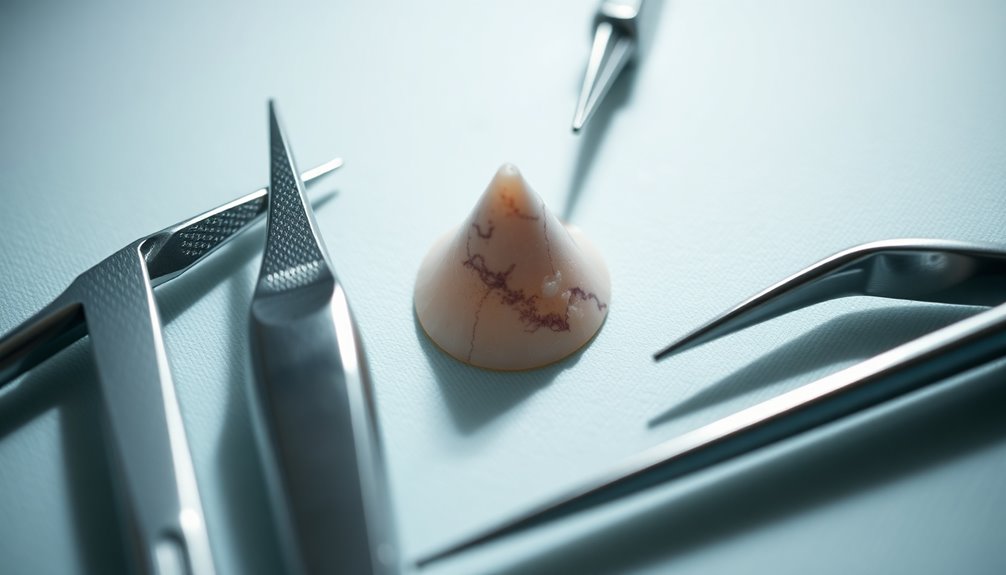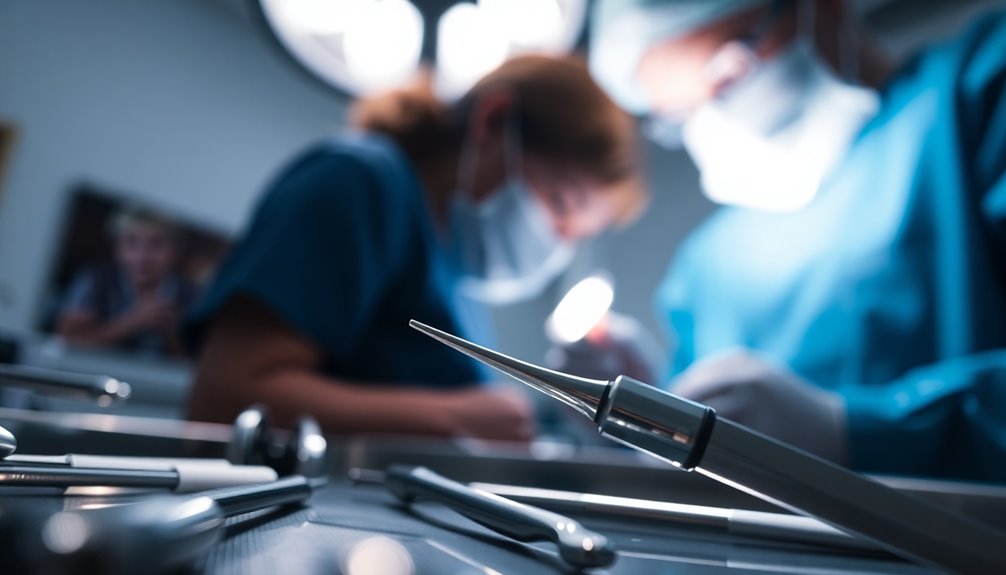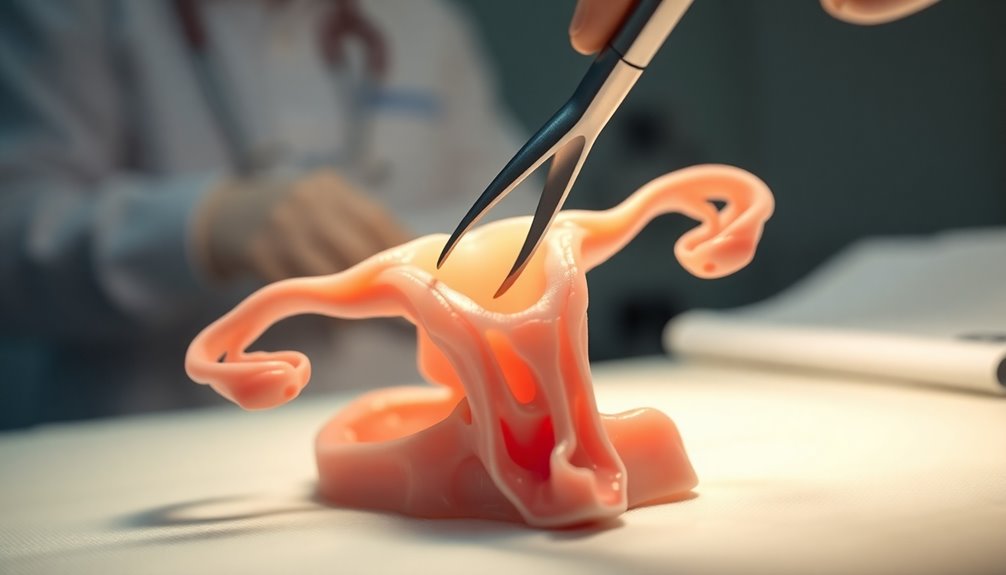Conization is a targeted surgical procedure that removes a cone-shaped piece of cervical tissue to address and diagnose abnormal cervical cells. It's often done when Pap smears show signs of dysplasia or early-stage cervical cancer. You'll likely be under general anesthesia, and recovery can involve some cramping and bleeding. Understanding the risks and what comes next is essential for your health. Stick around to learn more about what to expect and how to care for yourself afterward.
Key Takeaways
- Conization is a surgical procedure that removes cone-shaped cervical tissue to diagnose and treat abnormal cells from Pap smears.
- It can be performed using methods like Cold Knife Conization (CKC), LEEP, or laser conization, depending on the situation.
- Indicated for cervical dysplasia, unclear biopsy results, and early-stage cervical cancer, conization helps prevent cancer progression.
- Recovery involves managing mild cramping and vaginal bleeding, with follow-up Pap tests recommended every six months.
- Risks include excessive bleeding, infections, and potential complications affecting future pregnancies and screenings.
What Is Conization?

Conization is a targeted surgical procedure designed to remove a cone-shaped section of cervical tissue. This procedure helps diagnose and treat abnormal cervical cells, often identified through Pap smear results.
You might encounter three common methods of conization: Cold Knife Conization (CKC), Loop Electrosurgical Excision Procedure (LEEP), and laser conization. Each method has its own benefits and potential risks.
Typically performed under general anesthesia, conization lasts about 15 minutes, though you'll need time for pre- and post-operative care. After the procedure, expect some manageable cramping and vaginal bleeding.
You'll need to avoid sexual activity and heavy lifting for about four weeks. Regular follow-up appointments and Pap tests are essential to monitor for any remaining abnormal cells or recurrence.
Indications for Conization

When abnormal cell changes show up in a Pap smear, that's often the first indication that conization might be necessary. This procedure is particularly indicated for cervical dysplasia, where precancerous lesions are detected.
If you have early-stage cervical cancer (stage 0 or IA1), conization can help remove affected tissue and prevent further progression. It's also recommended when prior diagnostic methods like colposcopy and punch biopsy don't provide clear results.
For women with persistent high-grade cervical intraepithelial neoplasia (CIN2 or CIN3), conization becomes vital due to a higher risk of developing cervical cancer.
Types of Conization Procedures

Several types of conization procedures are available, each tailored to specific clinical needs and circumstances.
The Cold-Knife Conization (CKC) uses a surgical knife to remove a cone-shaped segment of cervical tissue. This method allows for precise margin evaluation but comes with a higher risk of bleeding and requires general anesthesia.
Another option is the Loop Electrosurgical Excision Procedure (LEEP), which employs an insulated wire loop and is often done under local anesthesia. LEEP preserves the excised tissue for histological analysis.
The Loop Electrosurgical Excision Procedure (LEEP) uses an insulated wire loop and local anesthesia, preserving tissue for analysis.
Finally, Laser Conization is effective but less common due to high costs and the need for specialized training.
Your doctor will choose the best technique based on factors like the extent of abnormal tissue and your overall health.
Preparing for Conization

Before your conization, you'll need to follow specific pre-procedure instructions to guarantee everything goes smoothly.
It's also essential to have emotional support during this time, as the anticipation of the procedure can be overwhelming.
Let's talk about what you can do to prepare effectively.
Pre-procedure Instructions
Preparing for conization involves several important steps to secure your safety and the success of the procedure.
First, review your medical history and discuss any medications, allergies, or health conditions with your healthcare provider, guaranteeing safe anesthesia management.
Avoid sexual intercourse, douching, and using tampons for at least 48 hours before the procedure to reduce the risk of infection and allow a clear view of the cervical area.
It's also essential to arrange transportation, as you may be under general anesthesia or sedation, impairing your ability to drive.
Finally, if general anesthesia is planned, follow fasting instructions for 6-8 hours prior to the procedure to minimize complications and secure a smooth experience.
Emotional Support Importance
Understanding the emotional impact of undergoing conization is essential, as feelings of anxiety and uncertainty can arise during this time.
Emotional support from family and friends plays a significant role in maintaining your mental well-being. Open conversations about your fears and expectations can help alleviate feelings of isolation and provide reassurance.
Connecting with others who've faced similar procedures can also offer comfort and valuable insights. Don't hesitate to seek guidance from healthcare providers, as they can address your questions and uncertainties about the process and recovery.
By prioritizing emotional support, you'll enhance your resilience, making it easier to cope with both the physical and emotional challenges that come with conization.
You're not alone in this journey.
What to Expect During the Procedure

During the conization procedure, you'll have options for anesthesia, so you can choose what feels best for you.
The surgeon will use a specialized technique to remove a cone-shaped piece of cervical tissue.
Afterward, you can expect a timeline for recovery and follow-up appointments to monitor your healing.
Anesthesia Options Available
Choosing the right anesthesia for your conization procedure is essential for a smooth experience.
Generally, general anesthesia is used for procedures like Cold Knife Conization or LEEP, ensuring you're comfortable and still during surgery. This option minimizes the risk of motion and manages potential bleeding from extensive tissue removal.
If you're a cooperative patient, local anesthesia might be an option, but it can lead to discomfort and anxiety during the procedure.
Discuss your anesthesia options with your healthcare provider before the surgery, as they'll help you weigh the benefits and risks based on your specific situation.
The choice of anesthesia will considerably impact your overall comfort and the surgical environment, so don't hesitate to express your concerns.
Surgical Technique Overview
As the procedure begins, you'll be positioned comfortably on the exam table, and a healthcare provider will explain each step to keep you informed.
Conization, also known as cone biopsy, typically takes about 15 minutes under anesthesia. A speculum and colposcope allow for clear visibility as the affected tissue is removed using a surgical knife or loop electrosurgical excision.
Here's what to expect:
- A cone-shaped piece of cervical tissue is excised for diagnosis and treatment.
- The site is monitored post-procedure to prevent excessive bleeding.
- You'll receive instructions for safe recovery, including avoiding sexual intercourse and heavy lifting.
This surgical technique helps guarantee accurate analysis while addressing abnormal cervical cells effectively.
Recovery Timeline Expectations
While you may feel anxious about the conization procedure, understanding the recovery timeline can help ease your mind.
This outpatient procedure lasts about 15 minutes, and you'll be monitored for a few hours before heading home. Expect some pain similar to menstrual cramps, which you can manage with medication.
For about four weeks, you'll need to avoid sexual intercourse and heavy lifting. Common side effects include cramping, discomfort, and light vaginal bleeding; however, contact your healthcare provider if symptoms worsen.
You'll have a follow-up appointment within four to six weeks to discuss healing and the test results from your removed tissue.
After that, regular Pap tests every six months guarantee your cervical health remains a priority.
Recovery and Aftercare

After undergoing a conization procedure, you'll likely experience some discomfort, akin to menstrual cramps, which can be managed with medication.
Your recovery will be closely monitored for a few hours post-procedure, and you'll need to avoid sexual intercourse and heavy lifting for four weeks. A follow-up appointment will be scheduled within four to six weeks to assess your healing and discuss test results.
During your recovery, keep these points in mind:
- Expect common side effects like cramping, discomfort, and light vaginal bleeding.
- Contact your healthcare provider immediately if you experience severe pain or excessive bleeding.
- Schedule Pap tests every six months until normal results are achieved.
Following these guidelines will help guarantee a smooth recovery.
Risks and Complications of Conization

Recovery from conization involves monitoring for potential risks and complications that can arise from the procedure.
You might experience excessive bleeding, with delayed bleeding occurring in about 2% of Cold Knife Cone cases. If you undergo the Loop Electrosurgical Excision Procedure (LEEP), be aware that it increases your risk of preterm delivery in future pregnancies, likely due to cervical incompetence from tissue removal.
Complications like cervical stenosis can also develop, making future evaluations more difficult. Infections are a risk too, highlighting how important it's to follow postoperative care instructions and maintain regular check-ups with your healthcare provider.
Cervical stenosis and infections can complicate recovery, emphasizing the need for diligent postoperative care and regular healthcare follow-ups.
Additionally, if surgical margins are positive, your treatment failure rates could be as high as 60%, stressing the need for thorough pathology evaluations.
Understanding the Results

After your conization procedure, understanding your pathology report is vital for your health.
It reveals the presence of any abnormal cells and guides your next steps, including any needed follow-up testing.
Regular check-ups are essential to monitor your cervical health and catch any issues early on.
Interpreting Pathology Reports
How can you make sense of your pathology report after a conization procedure? Understanding your pathology report is vital for your health. It reveals whether abnormal cells are present and the severity of any lesions, such as CIN1, CIN2, or CIN3.
- A clear margin means all abnormal tissue is removed, lowering recurrence risk.
- A positive margin indicates a need for further treatment.
- HPV test results help assess your future risk of cervical cancer.
Familiarizing yourself with terms like "dysplasia" and "invasive carcinoma" is essential.
These insights guide your treatment options and future monitoring, ensuring you're well-informed about your health moving forward.
Follow-Up Testing Importance
Understanding the importance of follow-up testing after a conization procedure can greatly impact your cervical health. Regular Pap and HPV tests are essential for monitoring any abnormal cells and preventing potential progression to cervical cancer. You should schedule these tests every six months until you receive normal results.
| Follow-Up Testing | Frequency | Impact on Health |
|---|---|---|
| Pap Tests | Every six months | Detects abnormal cells |
| HPV Testing | Every year | Identifies virus presence |
| Monitoring | Ongoing | Guarantees timely intervention |
| Cervical Health | Continuous | Reduces cancer risk |
Follow-Up Care After Conization

Following conization, it's vital to prioritize your follow-up care to guarantee proper healing and monitor for any potential issues.
You'll need to schedule regular Pap tests to check for residual or recurrent cervical intraepithelial neoplasia (CIN). Here are some key points to remember:
- Refrain from sexual intercourse and using tampons for 2-3 weeks post-procedure.
- Watch for excessive bleeding; contact your doctor if you notice significant bleeding or complications.
- Attend follow-up appointments to assess healing, discuss pathology results, and evaluate any need for additional treatments.
Complete healing of the cervix usually takes about six weeks, so stay alert for symptoms like severe pain or prolonged bleeding.
Prioritizing your follow-up care is essential for your health.
Future Considerations and Controversies

As new research emerges, the landscape of cervical cancer screening and treatment continues to evolve, raising important questions about best practices.
You might wonder about the implications of cervical stenosis, a condition that can develop post-conization, affecting future screenings and treatments. The natural progression of cervical cancer precursors remains unclear, leading to debates on the ideal frequency of screenings and the need for biopsies in cases like ASCUS or LSIL.
High-risk HPV-DNA testing could help reduce unnecessary biopsies and conizations by clarifying progression risks. Additionally, persistent HPV infection is a significant predictor of treatment failure, highlighting the need for ongoing monitoring.
As research advances, the focus will remain on improving diagnostic accuracy and treatment efficacy, while minimizing overtreatment and enhancing patient outcomes.
Frequently Asked Questions
What Happens if a Cone Biopsy Is Positive?
If your cone biopsy comes back positive, it means there are abnormal or cancerous cells present.
You'll likely need further evaluation, which could include more extensive surgery to remove any remaining abnormal tissue.
Your healthcare provider will schedule follow-up appointments for additional tests, like Pap smears and HPV testing.
It's essential to discuss your results with your doctor to understand the implications and tailor a personalized care plan moving forward.
What Is the Difference Between a Cone Biopsy and a Conization?
A cone biopsy and conization are closely related but differ in scope.
When you undergo a cone biopsy, you're specifically having a cone-shaped piece of cervical tissue removed to diagnose or treat abnormal cells.
Conization, on the other hand, refers to the broader surgical process that includes various techniques like LEEP or cold-knife procedures.
Both aim to remove abnormal tissue, but the methods and implications can vary considerably.
What Is the Next Step After Cone Biopsy?
After your cone biopsy, the next step involves scheduling a follow-up appointment within four to six weeks.
During this visit, you'll discuss the pathology results and any further treatment options.
It's important to have Pap tests every six months until you achieve normal results.
Make sure to report any concerning symptoms, like severe pain or excessive bleeding, to your healthcare provider.
Open communication is key to your recovery and ongoing health monitoring.
Can a Cone Biopsy Remove Cancer?
Imagine a gardener pruning a tree to remove unhealthy branches. Similarly, a cone biopsy can effectively remove cancerous or precancerous cells from your cervix.
This procedure takes a cone-shaped slice of tissue, allowing doctors to treat early-stage cervical cancer. If successful, it can lead to cure rates exceeding 90%.
However, it's essential to follow up with regular Pap tests to guarantee your garden remains healthy and free from any new growths.
Conclusion
In summary, conization is a crucial procedure that can help detect and treat cervical issues early. Notably, studies show that about 50% of women who undergo conization may experience changes in their menstrual cycle afterward. Being aware of the indications, preparation, and potential risks can empower you to make informed decisions about your health. Regular follow-up care is essential to monitor your recovery and guarantee the best possible outcomes, so don't hesitate to reach out to your healthcare provider.









